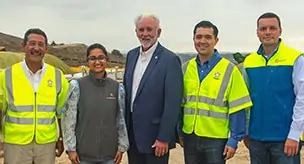

Organic waste diversion legislation enacted in 10 states aims to reduce landfill methane emissions. The success of such legislation should be measured by methane emissions reduction, not just organics diversion from disposal. This will help ensure we prioritize both waste reduction and environmental protection. In October 2023, the US Environmental Protection Agency (EPA) released its estimates of potential emissions reduction from food waste diversion on a national scale in a report titled “Quantifying Methane Emissions from Landfilled Food Waste.”[1] The challenge facing landfill owners and operators today is the noted limitations of direct measurement technologies for surface-level methane concentrations, which are years away from providing accurate annual methane emissions estimates.
Landfills now use EPA’s standardized regulatory landfill gas models (LandGEM or equivalent) to report methane emissions. These tools are easy to run, but their simplicity limits them to producing emissions estimates that are approximate at best. Landfill gas models struggle to accurately estimate methane generation, making them prone to error when defining emissions from organics diverted from disposal.

Alex’s presentation will summarize state-level legislation targeting organic waste before zeroing in on Washington’s HB 1799. HB 1799 sets a statewide goal to reduce organic waste disposal by 75 percent from 2015 levels by 2030, which would require a decrease from about 3 million tons in 2023 to 700,000 tons by 2030. Estimates of methane emissions reduction from diverting this waste from Washington’s landfills are prepared by running SCS and Inter-governmental Panel on Climate Change (IPCC) landfill gas models to project methane generation, from which assumed rates of methane collection and oxidation are applied to calculate net emissions. Projected reductions in annual methane emissions increase from about 7,500 metric tons (Mg) in 2030 to 17,000 Mg in 2040 and 21,000 Mg in 2050. Cumulative methane emissions reduction will exceed 157,000 Mg by 2040 and 350,000 Mg by 2050.
Achieving these levels of emissions reductions will depend on efforts by the state’s municipalities to develop or access an organics collection and processing infrastructure, which will be difficult in remote regions. Estimating impacts at the scale of municipalities and landfills requires developing a schedule for reducing organic waste disposal, which is achievable, reflects site-specific historical disposal rates, and accounts for prior progress towards the diversion goal. SCS is assisting municipalities in Washington and other states to meet the requirements of organics diversion legislation. This experience informs our calculations of organics diversion’s effects on methane emissions and our forecasts of methane fuel supply for renewable natural gas projects.
In October, Republic Services’ Otay Compost Facility at the Chula Vista, California, Otay Landfill opened for business. The compost facility helps communities in San Diego County meet the requirements of California’s SB1383 law mandating the diversion of organic waste from landfills.
The composting facility designed by SCS Engineers in collaboration with Sustainable Generation operates completely off the grid using solar energy. It is the first fully solar-powered compost facility in the state and can process 100 tons of organics per day, with plans to double capacity by year-end.
Both organics recycling and reuse leaders, Republic Services hired SCS Engineers to design the Otay Compost Facility. The design uses renewable energy to run 100 percent of the composting operations at the site. The facility design includes using technologies to speed the maturation rates and reduce excessive odors. Blowers to aerate the organic material, oxygen and temperature sensors, and advanced compost cover technology produce a high-quality product.

“Republic’s taken the goals of SB 1383, to reduce emissions of short-lived climate pollutants further. They’re running a sustainable facility that enables residents, businesses, and government to easily reuse and recycle more within a smaller carbon footprint than ever expected,” says Vidhya Viswanathan, engineer and project director.
As California collects and recycles organic materials from homes and businesses, local governments will use the products made from recycled organic material for compost and mulch. Recycling organic waste into compost creates a nutrient-rich soil amendment, preserving natural resources and reducing water consumption working within a circular economy. This California jurisdiction is ready for the SB1383 deadline on January 1, 2022.
“Republic Services supports California’s effort to divert food and yard waste from landfills to facilities such as this one,” said Chris Seney, Republic’s director of organics operations. “We’re grateful to SCS for their partnership in helping us bring this facility, co-located at an active landfill, to reality.”
Please watch the YouTube video to see the facility and learn more about its environmental value.
SCS Engineers is proud of helping our municipal and private clients bring the most value to their environmental solutions and communities. To learn more about SCS Engineers, view our 50th-anniversary video.